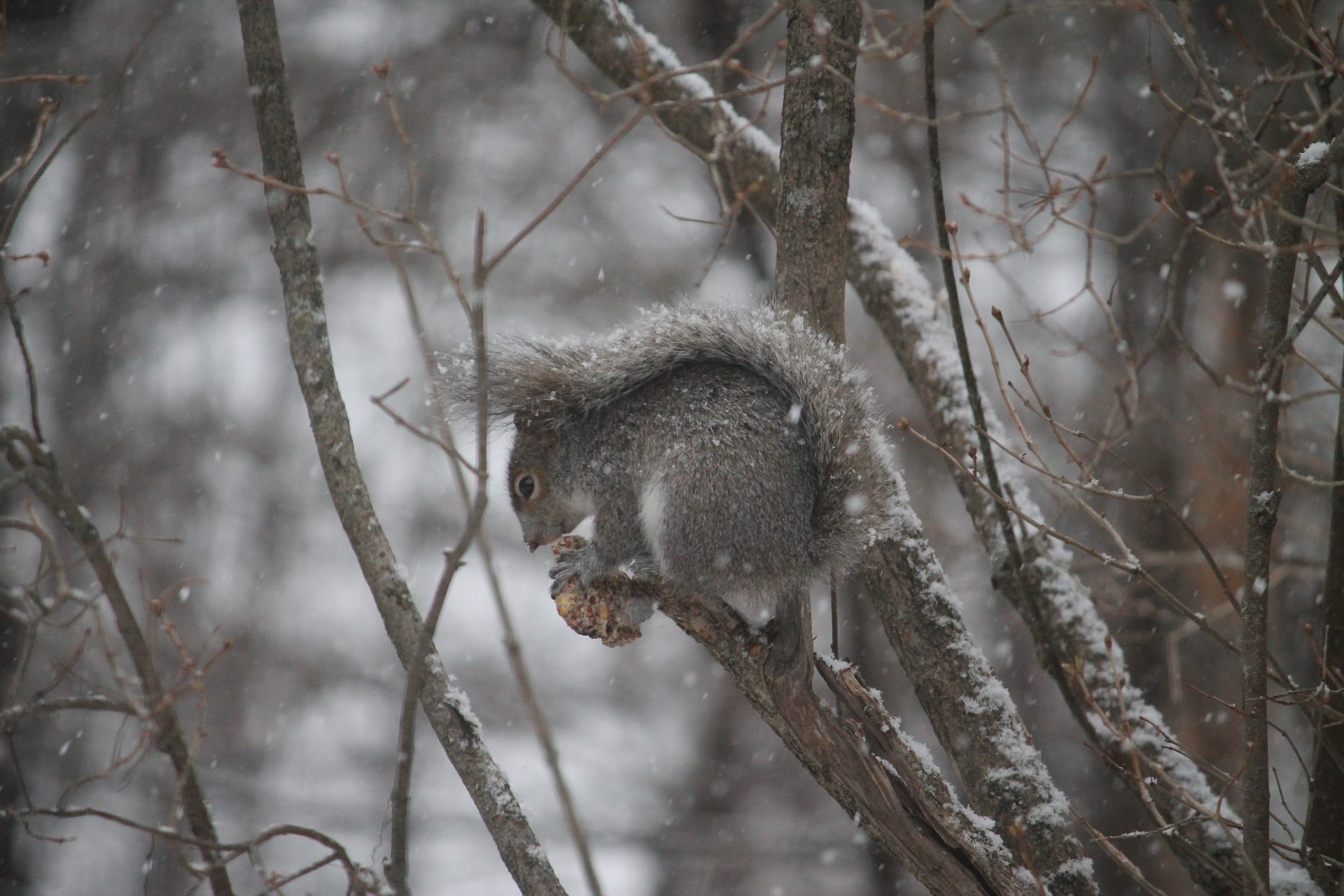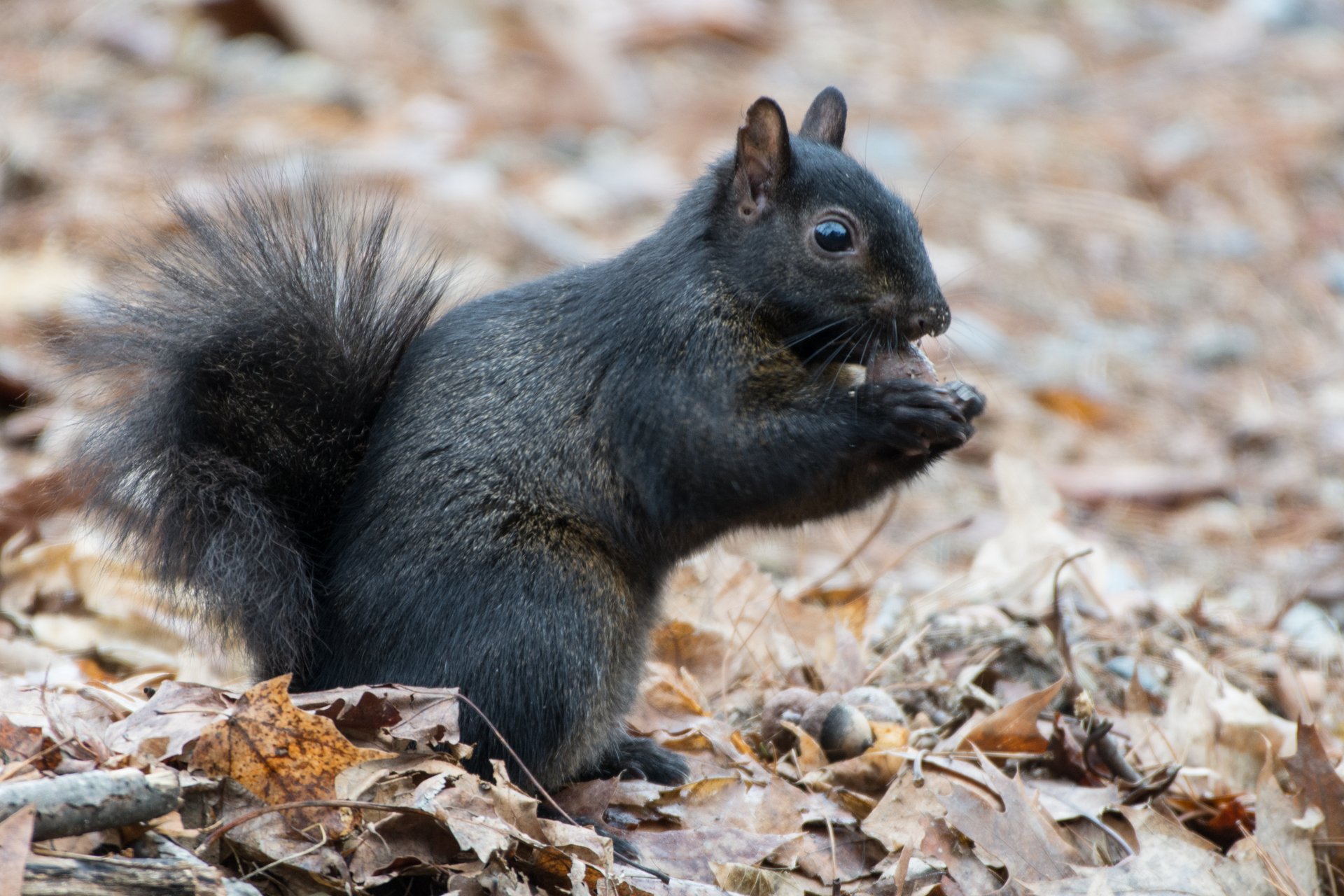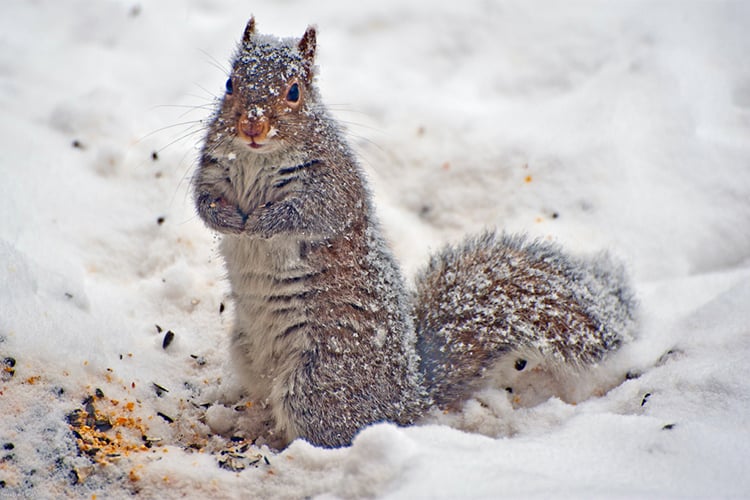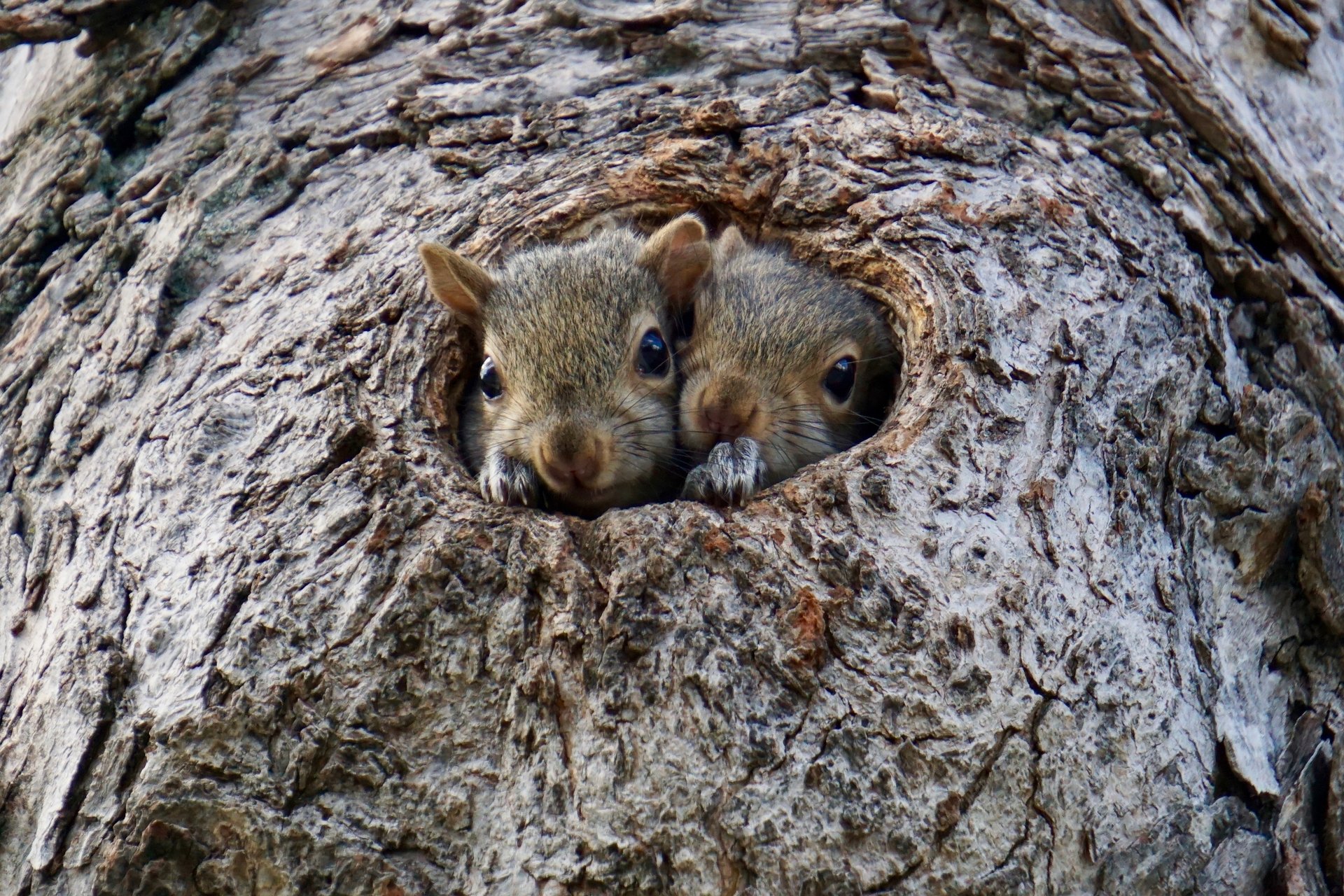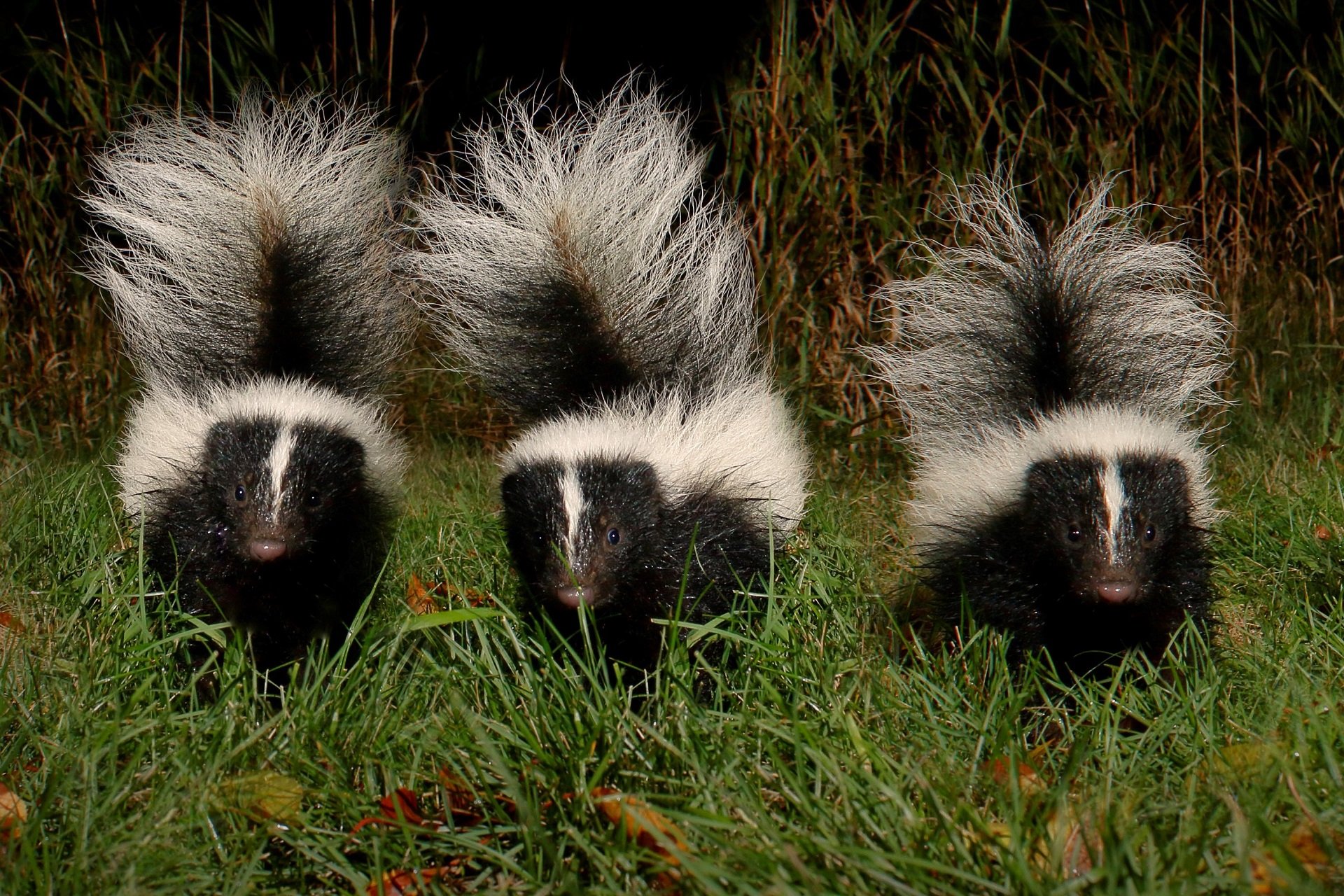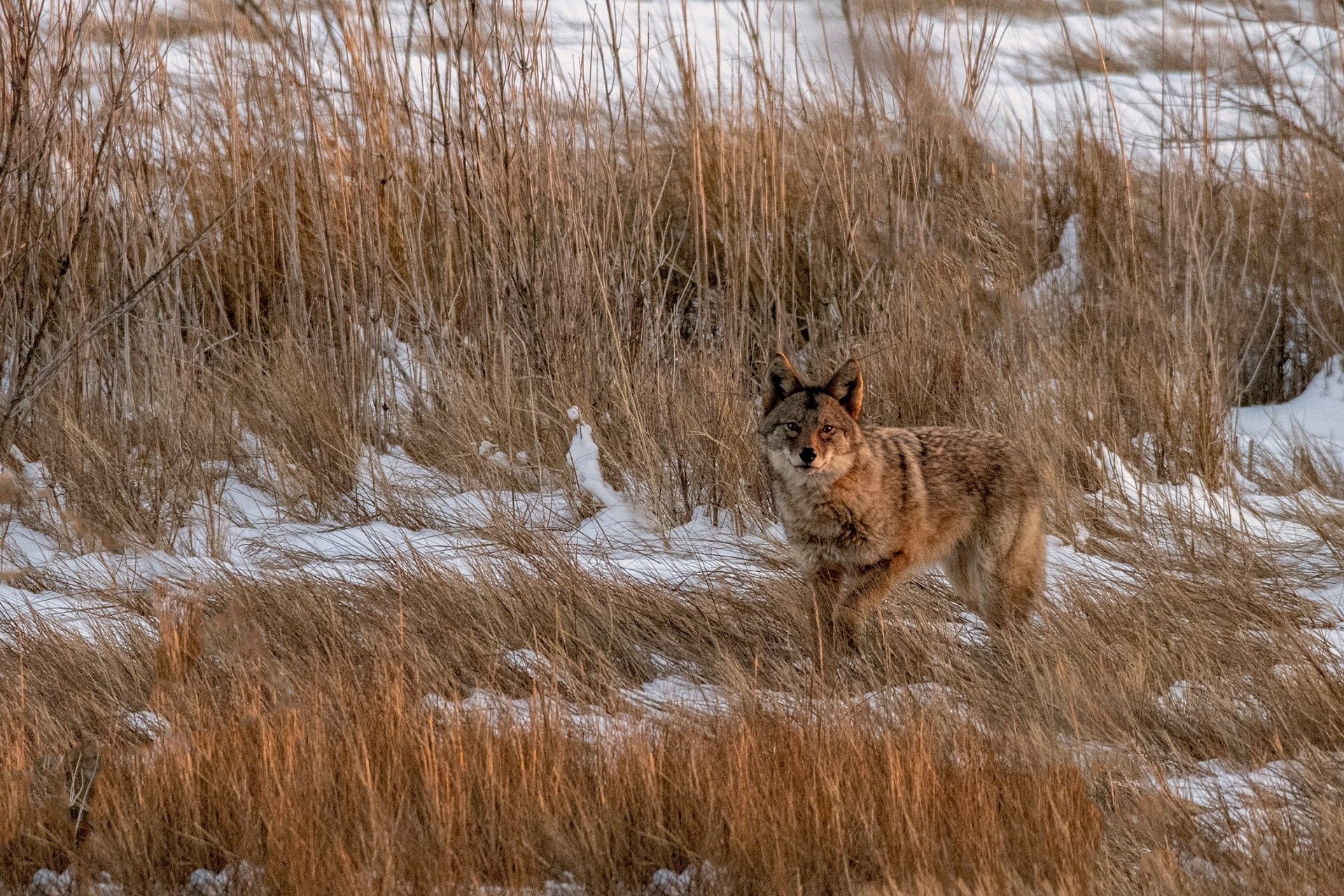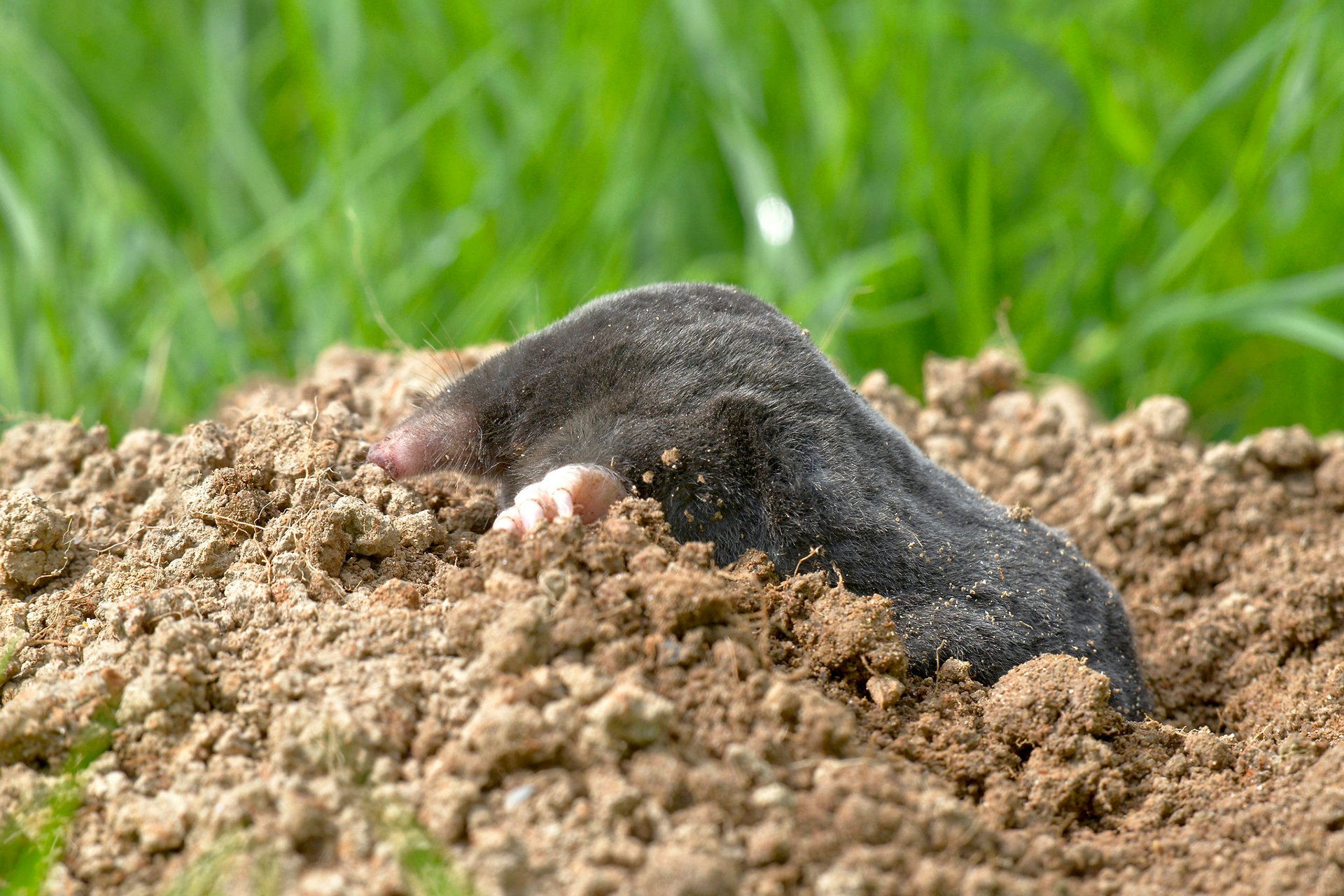Mammals in Massachusetts
Squirrels
Most New Englanders are familiar with the ever-present gray squirrel, Sciurus carolinensis, climbing on trees and running across open yards. An extremely adaptable species, gray squirrels are at home everywhere from midtown parks to oak forests. The less-common red squirrel can also be found in suburbs but is more at home in spruce and pine-dominated forests.
Squirrels are alert, inquisitive, and sometimes aggressive rodents. They can move as rapidly through treetops as they do on the ground and easily negotiate vines, shrubbery, telephone wires, downspouts, and walls of brick, stucco, or wood. They can jump six feet straight up and can launch themselves 10 feet or more from a tree, building, or railing to reach a bird feeder.
How to Identify a Squirrel
Squirrels remain active year-round and can feed during rain or snowstorms, generally keeping dry and warm under their broad tail, which they arch and spread over their back. Because their incisor teeth grow constantly, squirrels must constantly sharpen them by gnawing bark, wood, plastic, metal, or whatever is available.
Types of Squirrels Found in Massachusetts
There are three types of squirrels found in Massachusetts including the gray squirrel, red squirrel, and northern and southern flying squirrels.
Eastern Gray Squirrel
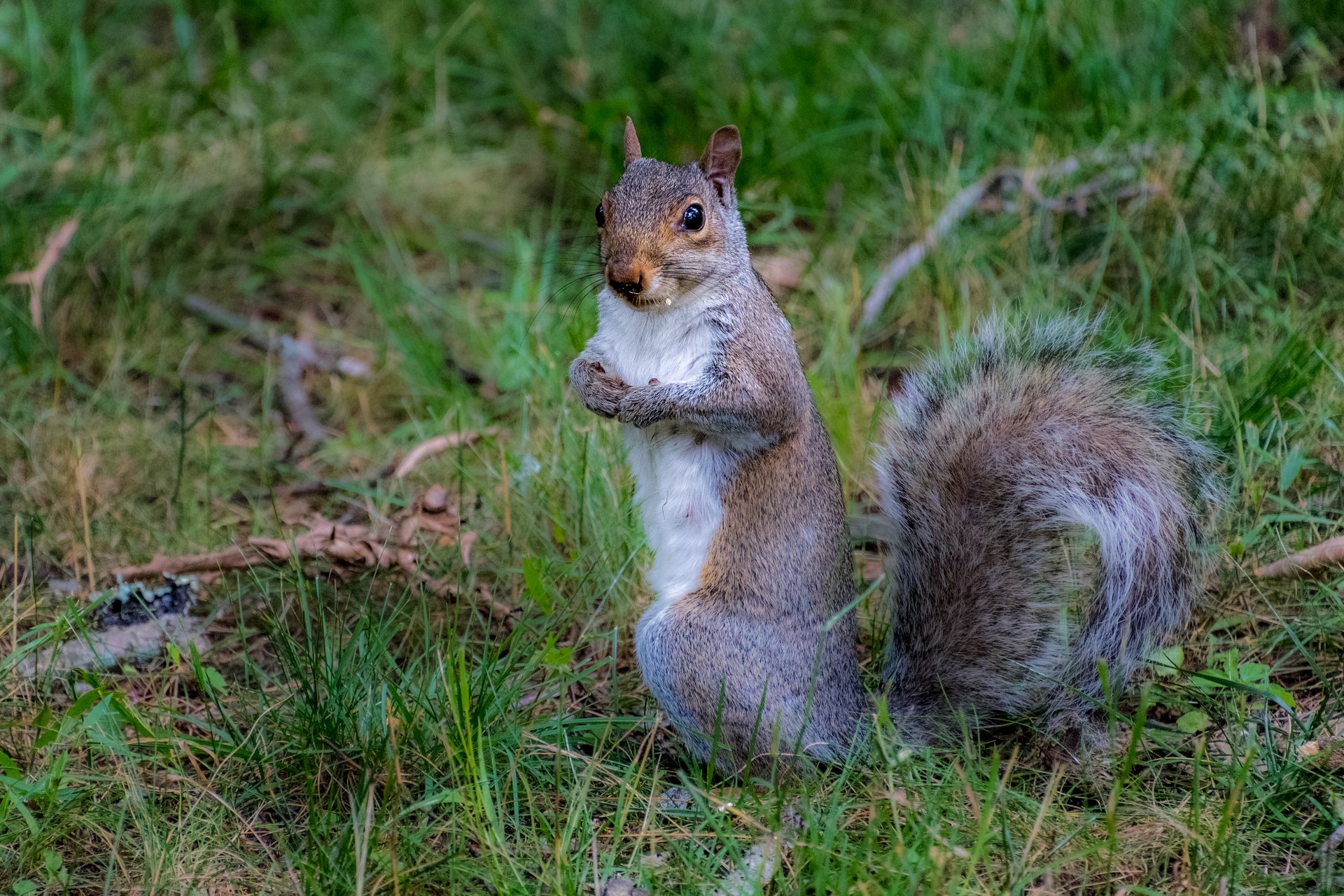
Gray squirrels are typically 17 to 20 inches long. They have large fluffy tails that are almost half their body length. They are typically gray with a white underside, but some can be black, brown, or white. During the spring, summer, and fall, gray squirrels are active at dawn and dusk, and in the winter, they only come out at midday. They are comfortable in suburban and urban areas and can be found across the state, including Martha’s Vinyard and Nantucket.
In summer, gray squirrels shelter in large leaf and twig nests called dreys. These nests are sometimes used as temporary quarters in winter if a food supply is nearby.
Red Squirrel
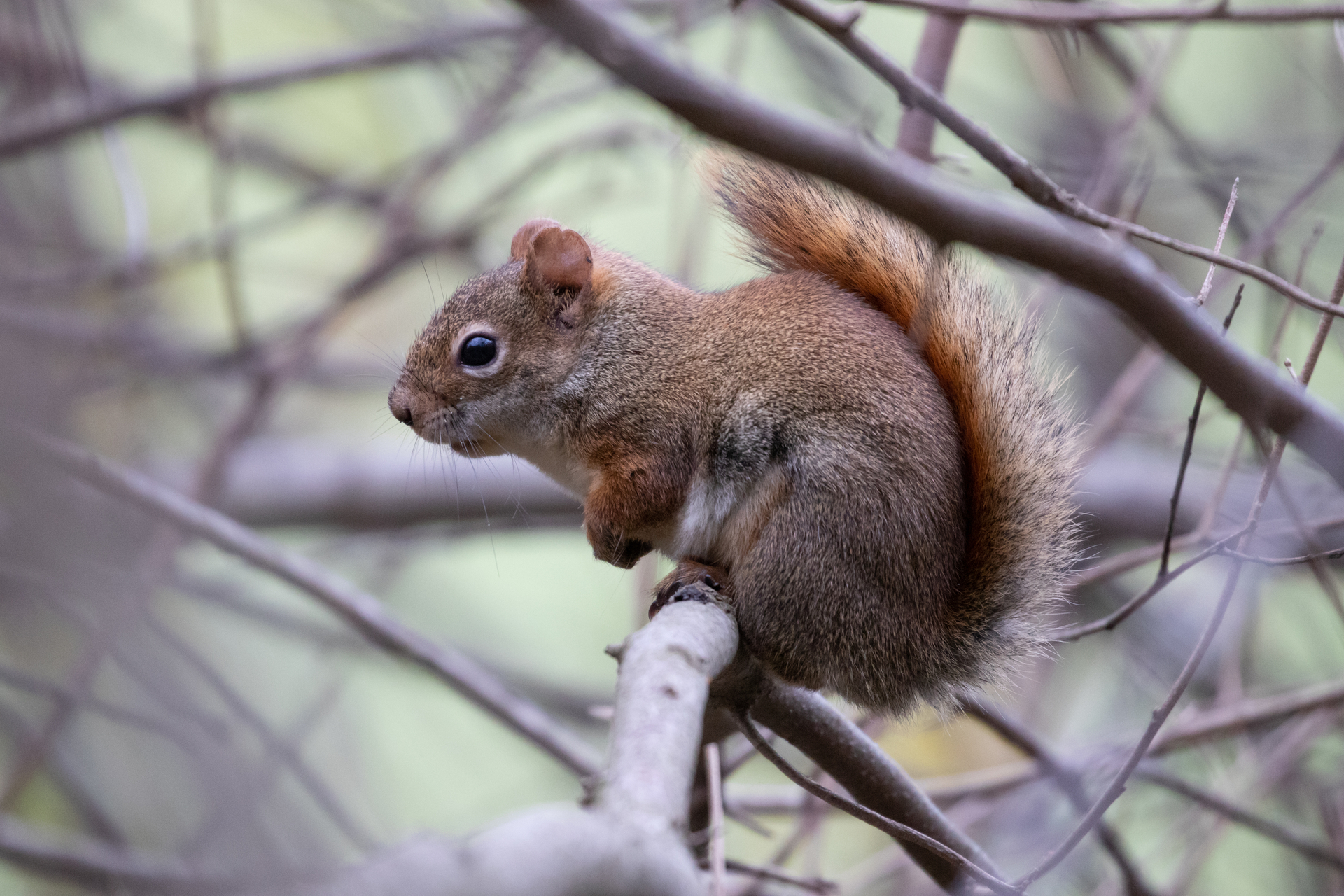
Red Squirrels are much smaller than gray squirrels, averaging about 12 inches long. They have reddish fur with a white belly and a white ring around their eye. Red squirrels are active throughout the day but may take a rest during midday. They are less tolerant of urban areas and absent from Martha’s Vineyard and Nantucket.
Red squirrels are cavity nesters; if a cavity isn’t available, red squirrels often nest in conifer trees. They weave together leaves, twigs, and inner bark so tightly that the nest is sometimes waterproof. In the winter, several squirrels can live in the same nest.
A favorite red squirrel snack is the seeds of pine and spruce cones. As cones are chewed apart to extract the seeds, the discarded scales pile into a group called a midden. After years of scales being discarded in the same spot, these middens can be up to two feet high.
Southern Flying Squirrel
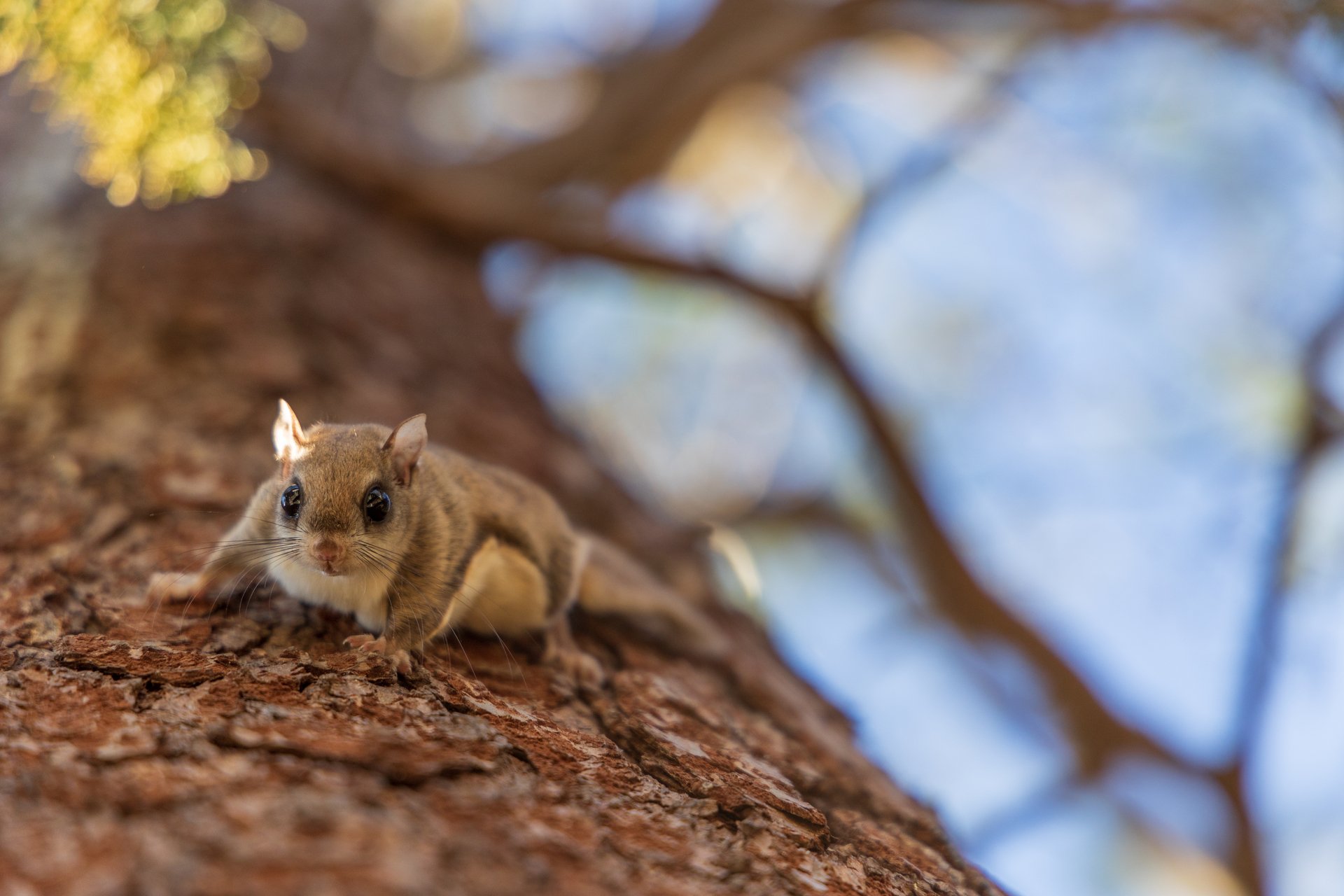
Southern Flying Squirrels can be found in many parts of Massachusetts, but they only emerge at night. They are 8-10 inches long and gray with a white belly. They have two breeding seasons, one in early spring and one in June.
Contrary to their name, flying squirrels don’t fly; they glide. Their flat tails and two flaps of skin connecting their front feet to the hind feet allow them to glide short distances, usually from tree to tree. These squirrels have been recorded gliding over 150 feet from a height of 60 feet.
Black and White Squirrels
Black squirrels or the occasional white squirrel are not a separate species—rather these are gray squirrels with more or less pigment than normal.
White squirrels are considered leucistic or albinistic. True albinos also have pink eyes.
Black squirrels are "melanistic," which refers to melanin, a chemical of pigmentation. The process of natural selection determines whether the black morph will be successful in a particular region. Although occasional melanistic gray squirrels are found throughout the gray squirrel's entire range (approximately the eastern half of the United States), the incidence seems to be greater in the North. Massachusetts has established populations located near Springfield and scattered throughout the suburban Boston area.
Gray Squirrel Behavior
Where to Find Gray Squirrels
In Massachusetts, look for gray squirrels wherever nut-bearing trees such as oak, hickory, or beech grow. When nuts are abundant, gray squirrels bury food for use during the winter. A highly developed sense of smell enables them to readily locate the cached food.
What Gray Squirrels Eat
In early spring, gray squirrels feed on buds and flowers of red and sugar maples, on tulip or crocus bulbs and blossoms, and later in the spring on the seeds of maple and elm trees. In summer they consume berries, apples, corn, and other grains. They also become predatory, taking birds' eggs and nestlings from open nests or gnawing their way into birdhouses to get at them. Of course, bird feeders provide a bonanza of nourishment.
Nuts make up a majority of a gray squirrel's diet year-round. This includes acorns, walnuts, beechnuts, and hickory nuts.
Squirrel Dreys
Eastern grays are large squirrels that thrive in urban and suburban environments. Not surprisingly, they make the biggest, most obvious nests. These structures can be a foot or two wide and are usually located 20 feet or higher up a tree that provides good squirrel food, like an acorn-bearing oak. For stability, they’re built near the trunk or at the fork of two strong branches. Learn more about squirrel dreys
Gray Squirrel Life Cycle
Two mating seasons occur per year, one in late January or February and another in late May or June. Courtship and mating are characterized by noisy, energetic chases through the treetops.
Following a 44-day gestation, the first litter of three to five young is born in March or early April, and the second in August or September. The eyes of the young open at four to five weeks and they’re weaned at 10 or 12 weeks. The first litter usually remains with the mother until the second litter is born in late summer.
How to Deter Squirrels from Bird Feeders
Squirrels love to eat seeds and can only assume the food you’ve put out for birds is for their benefit. The following suggestions will make it more difficult for squirrels to dominate a feeder. Just keep in mind the jumping abilities of squirrels: Even if a squirrel can’t gain a foothold on the feeder, they can knock it to the ground.
Pole-mounted Feeders
Place squirrel “baffles,” metal or plastic saucer-shaped disks, above and/or just below the feeder. A successful baffle is one that the squirrel can’t cling to, climb over or around, or gnaw through. Mount the baffles loosely so they readily tip when a squirrel lands on them. The pole should also be made of a smooth material such as metal or plastic so the squirrel can’t get its footing.
"Squirrel-proof" Feeders
Most commercial feeders, touted as "squirrel-proof," are at best, "squirrel resistant." The most successful is an all-metal feeder with adjustable springs that regulate a counterweighted door. When birds land on the platform, the door remains open, but under the heavier weight of a squirrel, the door drops down to block the food supply.
How to Deter Squirrels From Nesting in Your Home
Squirrels can sometimes turn up in attics, eaves, and walls; occasionally in chimneys; and maybe even your living areas. (To determine if it is a squirrel or a mouse, listen closely–mice make noise at night, while squirrels are heard coming and going in the morning and mid-afternoon). If the squirrel is visible, try to confine it to one area, open windows or doors, and leave the animal alone. Usually, the squirrel will discover the exits and happily leave on its own.
A squirrel that accidentally appears in a chimney or fireplace is incapable of climbing out. To help it escape, tie a rope (1/2-inch thick) around the top of the chimney and lower the other end all the way down to the damper. During the daytime, the squirrel will climb up the rope and out of the chimney.
If a squirrel has taken up residence, start by determining where the entrance hole is located. This is often best done as the squirrel comes and goes on its morning feeding trips. If you find multiple openings, permanently seal all but one. (You’ll want to dislodge the squirrel so that you can repair or close off the entrance hole(s) without trapping the animal inside.) If they live in the attic, you can usually encourage them to leave by making noise as you enter the attic during the day.
If you can’t determine whether the squirrel has exited, install a one-way door. After two or three days, if you don’t hear noises in the attic or eaves, remove the trap door and secure the opening with new wood covered with heavy gage hardware cloth (heavy half-inch wire mesh) extended six inches beyond the hole in all directions, to prevent the squirrels from chewing their way back in.
When undertaking the repairs, ensure permanent exclusion of squirrels (and other animals) by covering all vents, louvers, and chimneys with hardware cloth and by replacing all rotten wood.
Please Note: Baby squirrels are likely to be present between March and May and again in August through September. During this time, delay any removal attempt for 10 to 12 weeks, when the young are incapable of accompanying the mother outside.
Threats to Squirrels
In the wild, a squirrel’s average life span rarely exceeds four years. Predators that control squirrel numbers include hawks, coyotes, owls, foxes, and house cats. Automobiles and diseases like squirrel pox (sqPV) are also often fatal for squirrels.
How Mass Audubon Helps Squirrels
Squirrels are crucial to maintaining and balancing a healthy ecosystem. Mass Audubon is helping squirrels by protecting their habitats and building resilient landscapes where they can thrive. You can help us conserve and protect squirrels by becoming a member today.
Stay Connected
Don't miss a beat on all the ways you can get outdoors, celebrate nature, and get involved.



